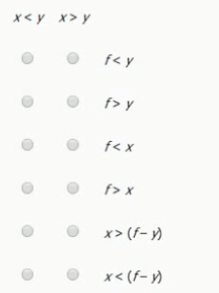Admission Tests GMAT - Graduate Management Admission Test (2022)
For each of the background colors, the graphic shows the average (arithmetic
mean) of the maximum prices that the participants who viewed the item with that
background reported that they were willing to pay for the item. Results are shown
for bath the auction and the negotiation scenarios.
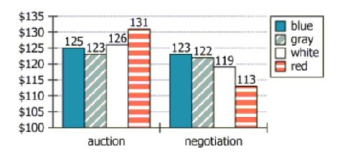
Assuming the researchers’ hypothesized link between offers and aggression is
correct, for each of the following background colors select More aggressive if, on
average, participants in the negotiation group in the study behaved more
aggressively when the product was displayed with that background color than the
participants did when the product was displayed with a gray background.
Otherwise, select Not more aggressive.
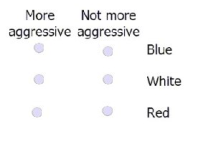
The color red has been shown to induce greater aggression in people than the
color blue. Researchers conducted a study to determine whether such colorinduced aggression could influence the amount that consumers were willing to
pay for an identical product in online auction and online negotiation scenarios.
The researchers photographed a single item against each of four background
colors: blue, gray, white, and red. Using a computer, each participant in the study
viewed the item against exactly one of the four background colors. Half of the
participants were told the item was up for auction and were asked to submit their
highest bid for the item. The other half of the participants were told to negotiate
a price with the seller and were asked to offer the highest amount that they
would be willing to pay for the item.
The researchers expected that participants who viewed the red background
would typically behave more aggressively than those who viewed the blue
background, Among the auction group, the researchers hypothesized that more
aggressive participants would submit higher bids as they tried to beat other
potential bidders, Among the negotiation group, the researchers hypothesized
that more aggressive participants would make lower offers as they tried to
compete against the seller to get the best deal.
Which of the following statements most accurately describes the relationship
between the study's results and the researchers’ hypotheses?
The color red has been shown to induce greater aggression in people than the
color blue. Researchers conducted a study to determine whether such colorinduced aggression could influence the amount that consumers were willing to
pay for an identical product in online auction and online negotiation scenarios.
The researchers photographed a single item against each of four background
colors: blue, gray, white, and red. Using a computer, each participant in the study
viewed the item against exactly one of the four background colors. Half of the
participants were told the item was up for auction and were asked to submit their
highest bid for the item. The other half of the participants were told to negotiate
a price with the seller and were asked to offer the highest amount that they
would be willing to pay for the item.
The researchers expected that participants who viewed the red background
would typically behave more aggressively than those who viewed the blue
background. Among the auction group, the researchers hypothesized that more
aggressive participants would submit higher bids as they tried to beat other
potential bidders. Among the negotiation group, the researchers hypothesized
that more aggressive participants would make lower offers as they tried to
compete against the seller to get the best deal.
Assuming the researchers’ hypothesized link between offers and aggression is
correct, for each of the following background colors select More aggressive if, on
average, participants in the negotiation group in the study behaved more
aggressively when the product was displayed with that background color than the
participants did when the product was displayed with a gray background.
Otherwise, select Not more aggressive.
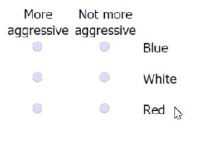
Journal
The editor of Metathesis, a new academic journal of literature, manages the peer-review of articles submitted for publication. The journal accepts articles focusing on any of three general subject areas: comparative literature, modernist literature, and postcolonial literature.
When an article is submitted, the editor has the article peer-reviewed by exactly three experts, none of whom authored or coauthored the article. The table (see the Reviewers/Authors tab) consists of all the authors or coauthors who have recently submitted articles and all the experts who currently peer-review or have recently peer-reviewed those articles. It also lists the general subject areas for each of the authors and reviewers.
Each author of each submitted article specializes in the general subject area of the article. Moreover, each recently submitted article was peer-reviewed by experts listed in the table.
Review Rules
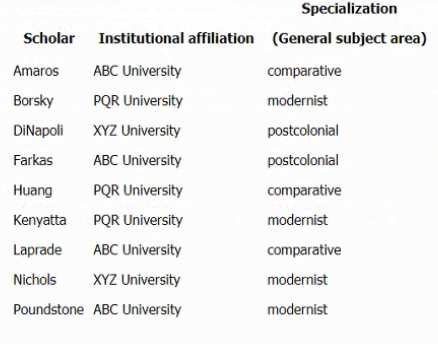
Suppose Laprade was the secondary reviewer of a recently submitted article. For each of the following statements, select Keslf the statement must be true, based on this supposition and the information provided. Otherwise, select Ato.
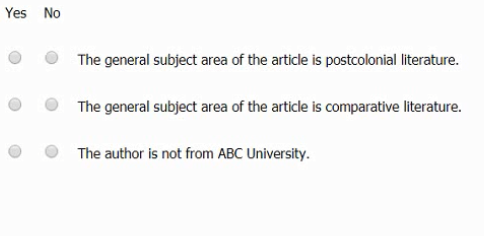
An orchestra conductor « planning the group's next concert. The orchestra will play a total of 3 pieces, and the conductor requires the total playing time of the 3 pieces to be at least 90 minutes but no more than 120 minutes. The pieces the conductor is considering are listed below with the approximate playing time.
First the orchestra will play one of two preludes:
• Prelude A (10 minutes)
• Prelude 8 (28 minutes)
Next they will play one of two classical piano concertos:
• Concerto A (32 minutes)
• Concerto B (48 minutes)
Finally they will play one of two romantic symphonies:
• Symphony A (35 minutes)
• Symphony B (41 minutes)
Based on these approximate lengths, select for Piece X and for Piece K two different pieces so that Piece X will be played before Piece Y, and if the conductor chooses Piece X, then in of def to comply with the given time constraints, the conductor must also choose Piece Y. Make only two selections, one in each column.
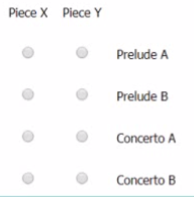
The manager of 6 employees, Employees A-F, will select a committee by choosing exactly 3 of the employees to be on the committee. The manager's supervisor recommended that Employee A not be chosen If either Employee C or Employee F (or both) is chosen.
Select for Number if recommendation not followed the maximum number of selections the manager has available If the recommendation is not followed, and select for Number If recommendation is followed the maximum number of selections the manager has available If the recommendation is followed, so that the selections are jointly consistent with the given information. Make only two selections, one in each column.
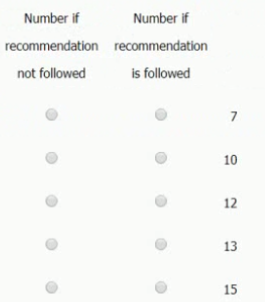
Welleby’s Plan
The water In the underground water table beneath the town of Welleby is moderately saline— 20,000millkjrarns of salt per liter of water (mg/L), or roughly half as saline as ocean water. To lower the level of the water table and thus prevent agricultural land from being inundated with salt water, the town plans to pump water from the table at a rate of 450kiloliters per day (kL/day) into a large shallow pond, allowing much of the water to evaporate. The town plans to divert 10percent of the water pumped from the water table to supplement Us supply of drinking water, which Is currently piped In from great distances. Due to the water's supply, the town intends to construct a desalination plant to treat the diverted water for use as drinking water.
Desalination Types
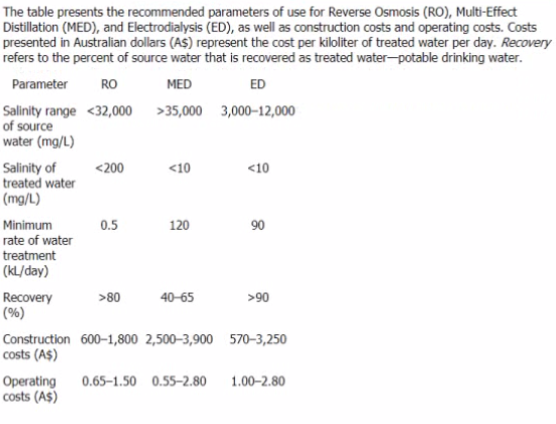
Comparison
Welleby is deciding among the following three desalination methods.
Reverse Osmosis (RO): Water Is pushed through a membrane, leaving salts behind. RO systems can handle a large range of water flow rates and use relatively little energy. However, RO membranes are expensive and must be replaced every 2 to 5 years. There is also a possibility that bacteria can grow on the membrane. Introducing tastes and odors Into the desalinated water.
Multi-Effect Distillation (MED): Saline water Is heated to produce water vapor, from which Is condensed potable fresh water. This process requires large amounts of energy, regardless of the salinity of the source water. It becomes more cost effective as water volumes increase.
Electrodialysis (ED): Electricity is used to selectively move salts through a membrane. Consumption of energy Is directly proportional to the salinity of the water to be treated, so with higher salinities the process rapidly becomes more costly than other methods. ED membranes need to be replaced every 7 to 10years.
Based on the information provided, which one of the following benefits to Welleby is most likely to result from Its building a desalination plant?




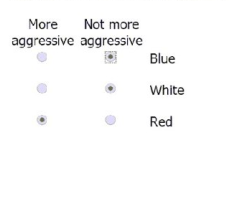 Chart, scatter chart
Description automatically generated
Chart, scatter chart
Description automatically generated


